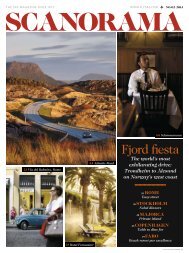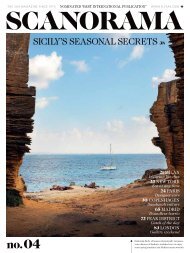Create successful ePaper yourself
Turn your PDF publications into a flip-book with our unique Google optimized e-Paper software.
PATA NEGRA<br />
It’s lunchtime in Badajoz in Extremadura,<br />
southwest Spain, and I’m leaning over the<br />
counter of a vast state-of-the art kitchen<br />
in the Monasterio de Rocamador examining<br />
different cuts of meat. This is not any<br />
old meat mind you, but beautifully sculpted cuts<br />
of Ibérico de bellota – pork from acorn-fed pigs –<br />
for which the region is famous. The richly marbled<br />
meat is as dark as good Bordeaux, almost the<br />
color of beef. My host, Carlos Tristancho, an actor<br />
turned pig farmer, is bent over the stove pressing<br />
his fingers into the top of a pork steak. “You can<br />
tell when it’s done by the bounce,” he says, before<br />
rushing off to scrabble in a cupboard for a pot of<br />
sea salt.<br />
Perched on a lonely ridge high above the dehesa<br />
– the rolling landscape of meadows and forests of<br />
holm oak and cork oak that the native Ibérico pig<br />
has roamed for mil len nia – the early 16th-century<br />
Franciscan mon as tery has a certain crumbling<br />
majesty about it. The unruly gardens seem to<br />
sprout from the founda tions and huge stork nests<br />
crown its disused chimney stacks. Inside, the<br />
rooms are dark and cool with mazelike corridors<br />
leading from living rooms and bedrooms to sunbaked<br />
terraces and shady porches.<br />
For the past 15 years this ancient stone building<br />
has been a hotel as well as a home, but it is on<br />
the market now that Tristancho is divorcing. “It<br />
had 30 bedrooms,” he says. “It was simply too big<br />
for us.” While I sip a nutty aged Manzanilla from<br />
Sanlúcar de Barrameda in Andalusia, Tristancho<br />
flutters about the kitchen. A raw cauliflower salad<br />
with sunflower seeds and soy sauce is paired with<br />
juicy slices of pluma (the triangular shaped muscle<br />
taken from just over the pig’s shoulder), which<br />
he serves rare – the Ibérico pig is trichina-free so<br />
you won’t get ill if the meat isn’t cooked through.<br />
While we eat, Tristancho regales me with stories<br />
of his acting career, including a role in Pedro Almodóvar’s<br />
first film Pepi, Luci, Bom (1980).<br />
It was then that he met his wife, Lucía Dominguín<br />
Bosé, the daughter of legendary bullfighter<br />
Luis Miguel Dominguín, whose circle in cluded<br />
Er nest Hem ing way, Lauren Bacall, Ava Gardner<br />
and Frank Sinatra, all of whom were avid<br />
ad mirers of the dashing matador and frequent<br />
guests at his estate during la temporada taurina<br />
(the bull fight ing season ). They would turn out<br />
to cheer him on at the corridas and in so doing<br />
sprinkle a little stardust over this remote corner<br />
of Spain. Tristancho, however, attracts a different<br />
kind of celebrity.<br />
His company, País de Quercus, supplies charcuterie<br />
to many of Spain’s top chefs: Andoni Luis<br />
Aduriz (Mu garitz), Manuel de la Osa (Las Rejas),<br />
Xavier Pelli cer (Can Fabes) and Joan Roca (El<br />
Celler de Can Roca), to name a few. Ferran Adrià<br />
and Britain’s Heston Blumenthal (The Fat Duck)<br />
swear by his meat. Tristancho, however, insists<br />
that they also get to know its provenance: the dehesa<br />
and its inhabitants.<br />
AND SO IT IS THAT ON A sweltering July day, after a<br />
late lunch and a long siesta, we find ourselves<br />
driving across the dehesa in Tristancho’s dusty<br />
4x4 to the Finca Cantillana, the farm where he<br />
raises 650 purebred Ibérico pigs, 350 head of<br />
Retinta cattle and 1,600 merino sheep. I had<br />
expected wild and untamed country, but the grass<br />
– or what is left of it since it has largely turned to<br />
dust now – is manicured to perfection thanks to<br />
the cattle and sheep that graze here before it is<br />
turned over to the pigs in the fall.<br />
The Ibérico pig is indigenous to the Iberian<br />
Peninsula and is a close descendant of Iberian<br />
wild boar. Extre madura fa vors two breeds: La<br />
Colorada, which is distinguished by its russet<br />
tones and com pact body; and La Negra, which is<br />
bigger and more cartoonish with an elongated<br />
snout and coarse black hair. Most have black<br />
feet – hence the term pata negra, or “black hoof,”<br />
referring both to the pig and the ham – but what<br />
differentiates these from just any old grain-fed<br />
Iberian pig is that during the montanera (fattening<br />
period) they scamper freely around the dehesa<br />
on a diet of acorns, fresh air and exercise, which<br />
Salad days: Tristancho<br />
(right) in the kitchen of the<br />
Monasterio de Rocamador ,<br />
which counts Ferran Adrià<br />
and Heston Blumenthal<br />
among its guest chefs<br />
86 DECEMBER 2012/JANUARY 2013 SCANORAMA












